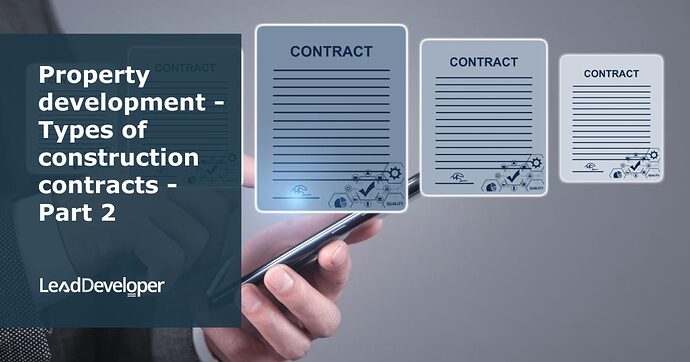Types of Contracts - Part 2
Here is an in-depth analysis of various contracting methods used in property development, including Design and Construct, TurnKey contracts, and the role of an Owner Builder.
It delves into the advantages and considerations of each type, aiming to offer valuable insights for developers and builders in managing their projects more effectively.
Design and Construct
Preferred for larger projects, where the contractor handles everything from hiring consultants to supervising construction. It offers faster schedules, reduced design and construction times, minimal variations, greater cost certainty, and reduced conflict.
TurnKey Contracts
Less common, involving tier one builders or government agencies, where the contractor designs, finances, and completes the project, offering the developer a clear price upfront.
Owner Builder
An option where the owner hires a construction manager who brings expertise, running the job on a fixed price, bonus, or monthly fee basis.
Frequently Asked Questions
What are the benefits of choosing a Design and Construct contract over other types?
Streamlined Process
It consolidates the design and construction phases under a single contractor, simplifying communication and project management.
Time and Cost Efficiency
This approach can significantly fast-track schedules and reduce both design and construction timeframes, leading to quicker project completion.
Risk Management
With the contractor taking on more responsibility, there’s reduced risk for the owner in terms of managing and coordinating the project.
Financial Predictability
It offers greater cost certainty, which can make the project more appealing to lenders and investors by minimizing variations and unexpected expenses.
Reduced Conflict
Having a single point of responsibility minimizes the potential for disputes between different parties involved in the project.
How do TurnKey contracts compare to traditional construction contracts in terms of cost and management?
Cost Clarity
TurnKey contracts provide the developer with an exact upfront cost of construction. This transparency is advantageous for budgeting and securing financing since it eliminates the uncertainty of fluctuating expenses that can occur with traditional contracts.
Management Ease
These contracts are designed to offload the management burden from the developer. The contractor is responsible for the complete design, financing, and execution of the project, making it a hands-off process for the developer.
This is particularly beneficial for developers who prefer to minimize their involvement in day-to-day construction management.
Time Efficiency
By having a single entity responsible for all aspects of the project, TurnKey contracts can streamline the process, potentially leading to faster completion times compared to traditional methods where separate parties handle design, financing, and construction.
What considerations should an Owner Builder make when hiring a construction manager?
Expertise and Experience
The construction manager should have a proven track record of managing similar projects. Their experience can bring invaluable insights into efficient project management, cost savings, and quality control.
Compensation Structure
It’s crucial to decide on a compensation model that aligns with both parties’ expectations. Options include a fixed price, a performance-based bonus, or a monthly fee. Each has its implications for the project’s budget and the construction manager’s motivation.
Responsibility and Authority
Clarifying the construction manager’s role and the level of authority they will have over project decisions is essential. This includes decisions related to subcontracting, purchasing, and on-site management practices.
Communication and Reporting
Establish a clear communication protocol, including regular updates and reports on the project’s progress, budget status, and any issues encountered. This ensures the Owner Builder stays informed and can make timely decisions.
Contractual Agreements
Ensure all terms, conditions, and expectations are clearly documented in a contract. This includes the construction manager’s responsibilities, project timelines, payment schedules, and any conditions for termination of the agreement.
What is a Design and Construct contract in property development?
A Design and Construct (D&C) contract is a method used in property development where the contractor is responsible for both the design and construction of the project. This includes hiring consultants, managing construction, and ensuring the project meets the client’s specifications.
Why are Design and Construct contracts preferred for larger projects?
They are preferred for larger projects due to their ability to offer faster schedules, reduced design and construction times, minimal variations, greater cost certainty, and reduced conflict between the design and construction phases.
What are the main advantages of using a Design and Construct contract?
The main advantages include faster project completion, reduced overall time for design and construction, fewer changes or variations during the project, better cost certainty, and less conflict between design and construction teams.
What is a TurnKey contract in property development?
A TurnKey contract is a construction agreement where the contractor is responsible for the entire project from design through to completion before handing it over to the developer. This type of contract often involves a fixed price agreed upon upfront.
How common are TurnKey contracts, and who typically uses them?
TurnKey contracts are less common and are typically used by tier one builders or government agencies. They are chosen for their simplicity in providing a complete solution with a clear, upfront price.
What are the advantages of a TurnKey contract for developers?
The primary advantage for developers is the clarity of having a fixed price for the entire project, reducing the risk of budget overruns and simplifying financial planning for the project.
What does it mean to be an Owner Builder in property development?
Being an Owner Builder means that the owner takes on the responsibility of managing the construction project. Instead of hiring a general contractor, the owner hires a construction manager to oversee the project on a fixed price, bonus, or monthly fee basis, bringing in expertise without taking on the full role of the contractor.
What are the considerations for someone thinking of becoming an Owner Builder?
Considerations include the need for a deep understanding of construction management, the time commitment required to oversee the project, the potential for cost savings versus the risk of project mismanagement, and the ability to hire and manage a construction manager effectively.
What are the advantages of choosing the Owner Builder option?
The advantages include potentially lower project costs, more control over the construction process, and the flexibility to make changes without dealing with a middleman. However, it requires significant time investment and construction knowledge.
Test Your Knowledge
Multiple-Choice Questions on Types of Contracts in Property Development
1. Which contract type is described as best suited for larger projects due to its comprehensive coverage from design to construction?
A) Owner Builder
B) TurnKey Contracts
C) Design and Construct
D) Cost-Plus Contracts
2. What is a primary advantage of TurnKey Contracts in property development?
A) They allow for significant design variations during the project.
B) They offer a clear, fixed price upfront for the entire project.
C) They are the most common type of contract used in the industry.
D) They are managed directly by the property owner without external help.
3. In the context of the Owner Builder option, what role does the owner take on?
A) The owner acts as the main contractor, overseeing every detail of construction.
B) The owner provides all the financing but does not participate in the construction process.
C) The owner hires a construction manager to oversee the project on a contractual basis.
D) The owner designs the project but hires others to construct it.
4. Which of the following is NOT listed as an advantage of Design and Construct contracts?
A) Reduced conflict between design and construction teams.
B) Faster project completion times.
C) More opportunities for design variations during the project.
D) Greater cost certainty for the overall project.
5. Who typically uses TurnKey Contracts for their projects?
A) Individual homeowners
B) Tier one builders or government agencies
C) Small-scale developers
D) Owner builders managing their own projects
6. What are the considerations for choosing an Owner Builder option?
A) High cost certainty
B) The necessity for a deep understanding of construction management
C) The desire for minimal involvement in the project
7. Which contracting method involves the contractor handling everything from hiring consultants to supervising the construction, offering faster schedules and reduced design times?
A) TurnKey Contracts
B) Design and Construct
C) Owner Builder
D) Fixed-Price Contracts
Answers:
- C) Design and Construct
- B) They offer a clear, fixed price upfront for the entire project.
- C) The owner hires a construction manager to oversee the project on a contractual basis.
- C) More opportunities for design variations during the project.
- B) Tier one builders or government agencies
- B) The necessity for a deep understanding of construction management
- B) Design and Construct
Assignment
Understanding Contract Types in Property Development
Objective:
To deepen your understanding of different contracting methods in property development, focusing on Design and Construct, TurnKey contracts, and the Owner Builder option. This assignment will involve research, analysis, and the application of concepts discussed in the provided material.
Instructions:
Complete the following tasks and prepare a report presenting your findings, analyses, and conclusions. Your report should be structured to include an introduction, body paragraphs for each task, and a conclusion summarizing your insights.
Task 1: Case Studies Analysis
- To Do: Research and find one real-life example of a property development project for each of the following contract types: Design and Construct, TurnKey, and Owner Builder. For each example, provide a brief overview of the project, including its scale, location, and outcome.
- Questions to Answer:
- How did the chosen contract type affect the project’s timeline?
- What were the key advantages and challenges faced by the project due to its contract type?
- Were there any notable conflicts or variations, and how were they managed?
Task 2: Comparative Analysis
- To Do: Create a comparative table that outlines the main features, advantages, and considerations of Design and Construct, TurnKey contracts, and Owner Builder options based on the provided material and your findings from Task 1.
- Research Question: Which contract type appears to be the most effective in terms of cost, time, and conflict management? Provide justification based on your analysis.
Task 3: Role Play Scenario
- To Do: Imagine you are a property developer about to embark on a medium-scale residential development project. Considering the information you’ve learned:
- Decide which contract type you would choose and explain your choice.
- Outline a brief plan on how you would approach the project management, including how you would handle hiring, design, and construction phases.
- Identify potential risks and how you would mitigate them using the advantages of your chosen contract type.
Task 4: Reflective Questions
- To Do: Answer the following reflective questions in your report:
- Based on your research and analysis, which contract type do you find most appealing if you were a developer? Why?
- How do the advantages of each contract type influence the decision-making process for developers and builders?
- How might the role of technology (e.g., project management software, BIM) impact the effectiveness of each contract type?
Submission Guidelines:
- Compile your findings, analyses, and reflections into a structured report.
- Ensure your report is clearly written, well-organized, and free of grammatical errors.
- Include any sources you have consulted or referenced in your research.
- Submit your report via mail or comments.



